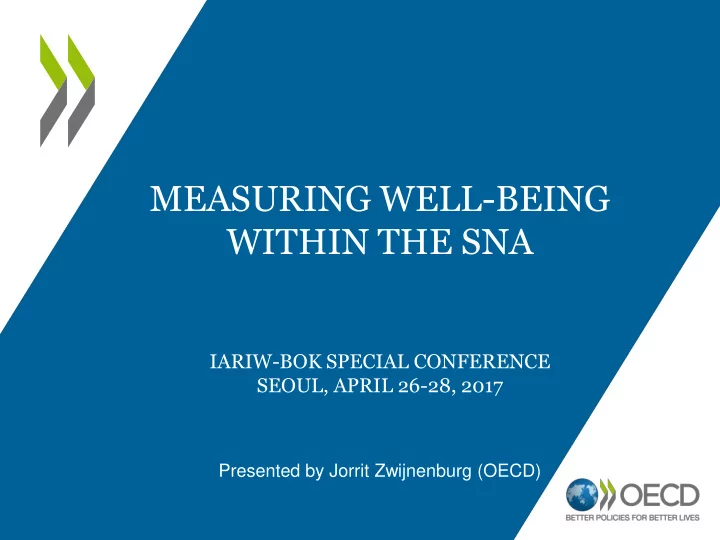

MEASURING WELL-BEING WITHIN THE SNA IARIW-BOK SPECIAL CONFERENCE SEOUL, APRIL 26-28, 2017 Presented by Jorrit Zwijnenburg (OECD)
Contents • Introduction • OECD’s Household Economic Well-being Dashboard • Distributional results within SNA framework • Satellite accounts: Extending the SNA boundaries • Unpaid household activities • Human capital • System of Environmental-Economic Accounting (SEEA) • Conclusions 2
Introduction: GDP versus well-being • GDP is an indicator of (the income generated by) economic activities. • GDP is not equal to welfare/well-being which are multi-dimensional phenomena: • Environmental issues • Unpaid activities • (Un)employment • Distributional aspects • Health • Security • … • 12 recommendations by Stiglitz, Sen and Fitoussi (2009). • Several initiatives within the System of National Accounts to have more insight in household well-being. 3
SNA-related measures of household material well-being OECD’s Household Economic Well -being Dashboard
The OECD Dashboard • Graphical representations of various indicators related to household well-being, mainly derived from NA data: • GDP and household income – 3 indicators • Confidence, consumption and savings – 3 indicators • Debt and net worth – 2 indicators • Unemployment – 2 indicators • Updated quarterly, 4.5 months after the end of the reference quarter. • A country-specific blog is published each quarter. • http://www.oecd.org/std/na/household-dashboard.htm 5
The OECD Dashboard 6
Introducing distribution in the SNA The work of the Expert Group on Disparities in National Accounts
Aim of the project Develop methodology to produce distributional results for household income, consumption, saving (and wealth) consistent with national accounts concepts using micro data sources. Household groups Q2 Q1 MACRO DATA Macro concepts -> Totals, growth Q3 Q5 Q4 MICRO DATA Micro concepts -> Distribution
Results: Ratio to average Relative position of each household group compared to the average, for adjusted disposable income 9
Results: Savings ratios Saving as a percentage of disposable income by equivalized disposable income quintile France Mexico United States 10
Satellite accounts: Extending the SNA boundaries 1. Unpaid household activities
Unpaid household activities • Currently excluded from central framework. • May lead to overestimation of GDP growth. • May hamper international comparisons. Satellite account to capture unpaid household activities: • How to value labour, capital and intermediate inputs? Three ways to measure labour input: Replacement costs, opportunity costs, and minimum wage approach. • How will the various accounts be affected? Not only changes in GDP, but also in household disposable income and final consumption. • Quality of time use data? • Note: UNECE Guide on Measuring Household Service Work. 12
Results: Value of unpaid activities Value of unpaid household activities as % of original GDP. 13
Satellite accounts: Including a capital approach 2. Human capital
Human capital • Labour is an important production factor . • More information is needed on the role of labour in the economy , its accrual over time, and who benefits. Satellite accounts to capture the role of labour: 1. Satellite account on education and training : Focus on current expenditures related to education and training. 2. Satellite account on human capital : • Changes the asset boundary: Human capital as produced asset and its creation as investment – Increases GDP. • Valuation: Cost-based approach versus lifetime income approach. Note: draft UNECE Guide on Measuring Human Capital. 15
Example: SA on Education and training Costs of education and training in Canada (billions of dollars). 16
Satellite accounts: Beyond current material well-being 3. Environmental-Economic Accounting
Environmental-economic accounting • Many interactions between economy and environment: • Natural resources used as input in production process • Well-being depends on sustainability of ecosystems • Environment may be affected by economic activities • A lot of interest in these interactions. System of environmental-economic accounting. Three sections: 1. Extended SUT that contain information on physical flows. 2. Functional accounts focusing on transactions related to environment (environmental taxes; environmental protection, etc). 3. Measuring capital stocks of natural resources and ecosystems. 18
Example: Functional information Environmental expenditure as percentage of GDP, 2013. 19
Example: Change in natural resources Freshwater abstractions in m 3 (index with 2000 = 100). 20
Conclusions • Well-being is a multi-dimensional phenomenon that should be analysed on the basis of multiple indicators. • Valuable information can be derived from the System of National Accounts (including satellite accounts) • A lot of progress has been made to have more focus on indicators related to household well-being, but a lot of work still needs to be done . 21
Thank you for your attention For more information please contact: Jorrit.Zwijnenburg@oecd.org 22
Recommend
More recommend